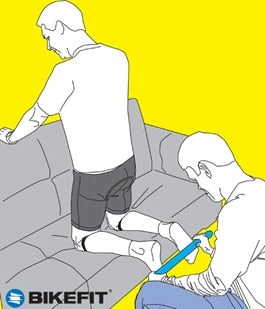Speedplay Cleat Wear
Taking into account pedal and cleat wear is often an overlooked aspect by many cyclists and bike fitters. In this article, we focus specifically on Speedplay cleat wear.
This information is static (will not be seen with motion capture or data capture during a bike fit). In other words, if your fitter only looks at dynamic (on the bike) data, they miss important information. Why? Although extremely important, dynamic fitting is just one aspect a fitter must consider.
The ultimate bike fit includes both dynamic AND static analysis (the cyclist and the bike or equipment) as well as consideration for how the cyclist feels. Keep in mind, how you feel is as actually more important than how you look on stick-figure printouts or a picture of you in a video.
Your Equipment Tells a Story
Take a look at your shoes. Turn them over and look inside the circle area of your Speedplay road cleat. MOST people notice uneven wear.


Do not be surprised when you see this. There is something you can do to alleviate the problem.
Next, look at the springs. Uneven wear inside the red circles is the norm–not the exception.

Why? The foot is naturally tilted and it wants to stay that way even if the equipment initially forced it flat. As a result, equipment wears out uneven.
Let’s also look inside of your shoe. One of our most popular illustrations is the one on the below where people say they feel more pressure on the outside of the foot. Why? The pedal and shoe are flat but the foot is tilted.

The Uneven Wear Culprit
Is this Speedplay’s fault? Absolutely not. All pedals are flat and wear out unevenly. For example, unlike running, in cycling, you can only buy shoes that function one way. All cycling shoes function the same regardless of price or brand (there is one brand that purports to include added tilt to the shoe but all of the shoes within that brand function the same). In running, even within one brand, you purchase shoes for different body architecture (stability, support, neutral…etc). In cycling, you only buy shoes that are flat at the forefoot. Consequently, you can now diagnose these problems, take a look at possible solutions, and connect with a BikeFit Pro to make your shoe/cleat fit the pedal properly.
Remember it is normal to see uneven wear, but normal does not necessarily mean right. It is also common to see the foot in a relaxed position hang with a tilt or angle to it.

First, you must flatten the foot or it won’t even clip into the pedal. We as cyclists learned to master this skill of leveling the foot to get into the pedal but we are hardly aware of it. Once clipped in, the foot tries to go back to its natural tilted position. Hence, uneven pedal wear.
The Solution: Cleat Wedges
Knee on a chair and ask someone to hold a straight edge across the bottom of your feet. They will most likes look like the figure on the right.


Foot tilt is the number one reason for uneven pedal/cleat wear and for most foot discomfort in cycling. This is why we need wedges.
Here is a rear view of Speedplay cleat with 2 cleat wedges.


If you would like more information regarding wedges, see our page on wedging benefits. We also reveal more information on the foot/pedal interface in another fitting article: How to Fit a Road Bicycle.
We have never seen a broken Speedplay spring from a cyclist that has a flat forefoot. However, a flat or neutral forefoot is rare, to say the least. This comment is not coming from Speedplay but it is absolutely our belief that the correct use of cleat wedges will prolong the life of your Speedplay cleat springs. Remember it is important to follow the manufacturer’s suggestion for upkeep and maintaining your equipment.
Interested in expanding your knowledge? Bike retailers and shop employees with a QBP account have access to educational resources within the U of Q Training Library. Get started now.
